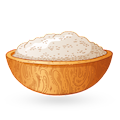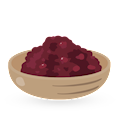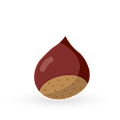MAIN INGREDIENTS
Uirō is a sweet Japanese cake consisting of sugar, rice flour, and water. The cake is traditionally steamed until it develops a chewy texture. It dates back to the 16th century, when it was used as a part of Japanese tea ceremonies, a tradition that is also practiced today.
There are a number of variations on the cake, so it can be flavored with ingredients such as matcha, chestnuts, strawberries, or azuki bean paste. Although it's made from the same ingredients as mochi, the method of preparation is different - uirō is poured into a mold and steamed, while mochi is pounded in order to become sticky.
MAIN INGREDIENTS
Shio daifuku is a traditional confectionery which consists of chewy mochi shells filled with creamy or coarse anko red bean paste. Unlike other daifuku varieties, the red bean paste in shio daifuku is lightly salted, which results in an unusual combination of sweet and savory flavors.
They are usually round, and occasionally whole black beans are incorporated in the mochi wrapper. These soft cakes are a staple at many specialized daifuku shops, but they can also be commonly found in many stores and supermarkets throughout the country.
Honey toast, also known as Shibuya toast, is a decadent dessert originating in Japan, particularly in Tokyo's Shibuya district, whose distinct feature is thick slices of bread, typically shokupan, either cut halfway through without being hollowed out or hollowed out to form a box.
If not hollowed out, the bread is spread with butter and honey and then baked under a broiler. If hollowed out, the removed bread is cubed, toasted, coated with honey or butter, then placed back into the hollowed bread. It's topped with drizzled chocolate or ice cream, but honey or syrup, whipped cream, fresh fruits like strawberries or bananas, and sometimes nuts or chocolate chips can also be used.
MAIN INGREDIENTS
This traditional Japanese dessert couples boiled mochi (rice cakes) and a vibrant green paste consisting of mashed edamame beans. Zunda mochi is typically associated with Sendai, but it is common throughout the entire Tohoku region. The dessert usually employs unsweetened mochi cakes, while the coarsely mashed paste is only lightly sweetened.
This simple combination can be enjoyed well-chilled or lukewarm, and the paste is usually served on top of mochi.
Mizu manjū is a unique Japanese confectionery made with the starchy kuzuko powder. The mixture of sugar, water, and kuzuko creates an almost transparent treat with a jelly-like consistency. Traditionally, sweetened red bean paste is used as a filling, but today mizu manjū appears in numerous variations.
This light, watery dessert is usually enjoyed as a refreshing summer treat.
Rakugan are traditional Japanese sweets prepared in many different colors and shapes reflecting seasonal, holiday, or regional themes. They are made by pressing sugar, soybean flour, and various powders in traditional wooden molds, known as kashigata.
It can be said that rakugan is not just a sweet, but an art form in itself. It is often consumed at tea ceremonies and festivities such as Christmas. The flavor of rakugan is that of pure sugar, since it is similar to regular sugar cubes used for tea in the West.
MAIN INGREDIENTS
Kaminari-okoshi, often called merely okoshi, is a popular Japanese confectionery, similar to rice crispy treats. The main ingredient in okoshi is expanded rice, created by roasting rice grains until they pop. A mix of sugar and butter or corn syrup is used to hold the rice together, and after the additional ingredients have been added, the mixture is formed or pressed in trays, left to dry, then cut into square shapes.
This crispy Japanese treat first appeared during the mid-Edo period in Japan and was primarily sold by street vendors in the vicinity of Buddhist temples in Asakusa, one of the districts in Tokyo. Originally, peanuts were added to enrich okoshi, but modern versions also include other nuts, dried fruit, chocolate, or sesame seeds, along with other exotic and interesting flavors such as matcha green tea or caramel.
Amanattō is a traditional dry dessert consisting of boiled beans (usually azuki or black soybeans), sugar, and sugar syrup. It is believed that the dessert originated in the early 1860s, when sugar became available in Japan for the first time. The first amanattō was invented by Hosoda Yasubei, who opened a wagashi store in Tokyo shortly after.
He used azuki beans, sasage cowpeas, and soramame green beans to make the first amanattō. Today, amanattō is extremely popular in Japan, especially among the older generations, since it is regularly served with tea in numerous Japanese retirement homes.
MAIN INGREDIENTS
Kashiwa-mochi is a chewy Japanese rice cake that is filled with red bean paste and wrapped in oak leaves. Even though the leaves are not edible, they provide these tender cakes with an unusual earthy flavor. It is one of the traditional mochi varieties which is typically served on Children's’ Day, a Japanese national holiday celebrating the well-being and prosperity of children.
Kuzumochi is a light Japanese dessert made with starchy kuzuko powder. This natural and unprocessed powder is extracted from the kuzu plant and is widely used in Japan as a thickening agent. To make kuzumochi, it is simply dissolved in sweetened water and the mixture is poured in molds and left to set.
Kuzumochi is characterized by its gelatinous texture and mild flavor, which make it a perfect summer dessert. It is usually served chilled, dusted with roasted soybean powder and doused in brown sugar syrup.
TasteAtlas food rankings are based on the ratings of the TasteAtlas audience, with a series of mechanisms that recognize real users and that ignore bot, nationalist or local patriotic ratings, and give additional value to the ratings of users that the system recognizes as knowledgeable. For the “33 Worst Rated Japanese Desserts” list until March 26, 2025, 2,449 ratings were recorded, of which 2,061 were recognized by the system as legitimate. TasteAtlas Rankings should not be seen as the final global conclusion about food. Their purpose is to promote excellent local foods, instill pride in traditional dishes, and arouse curiosity about dishes you haven’t tried.






























